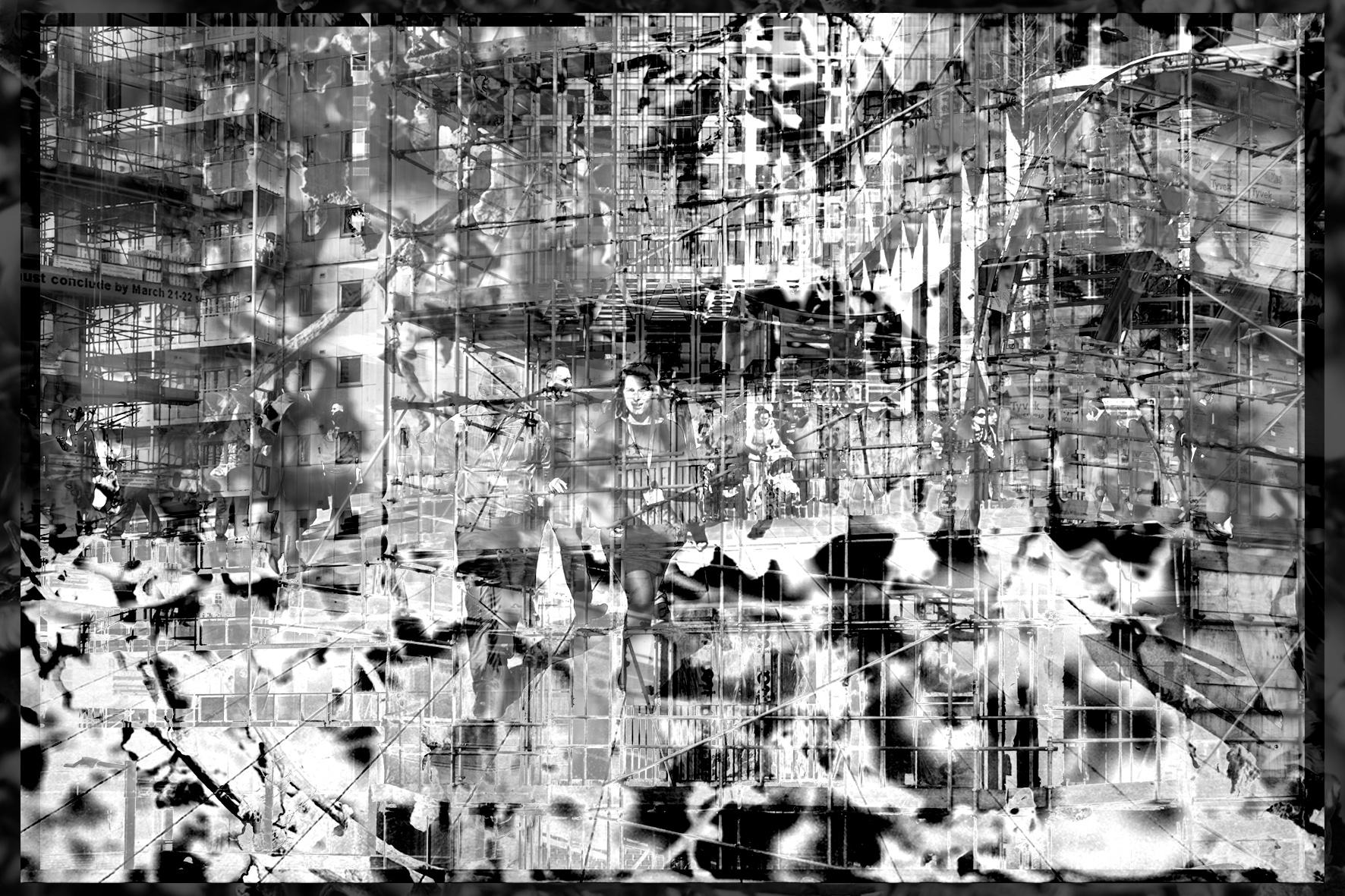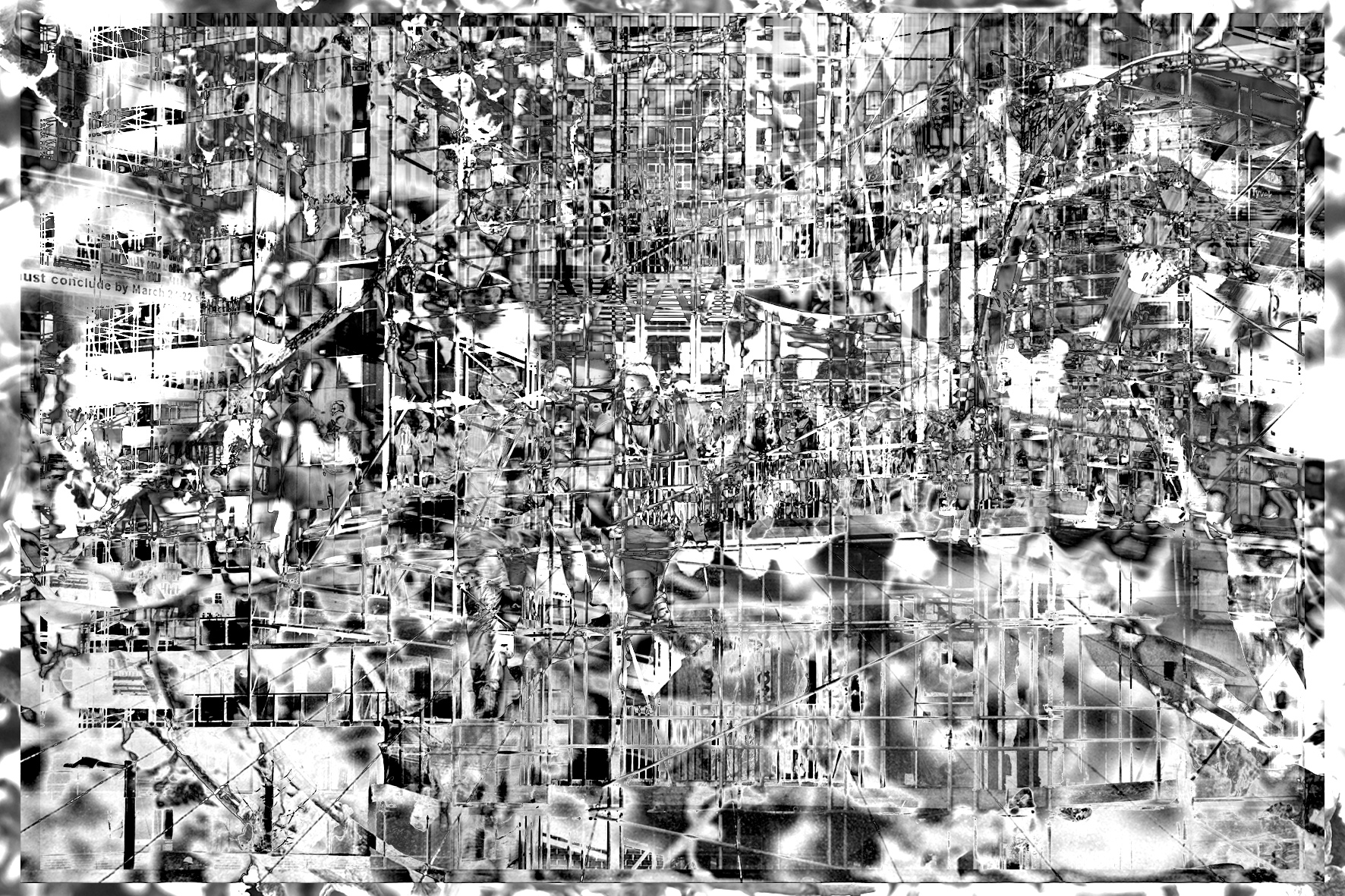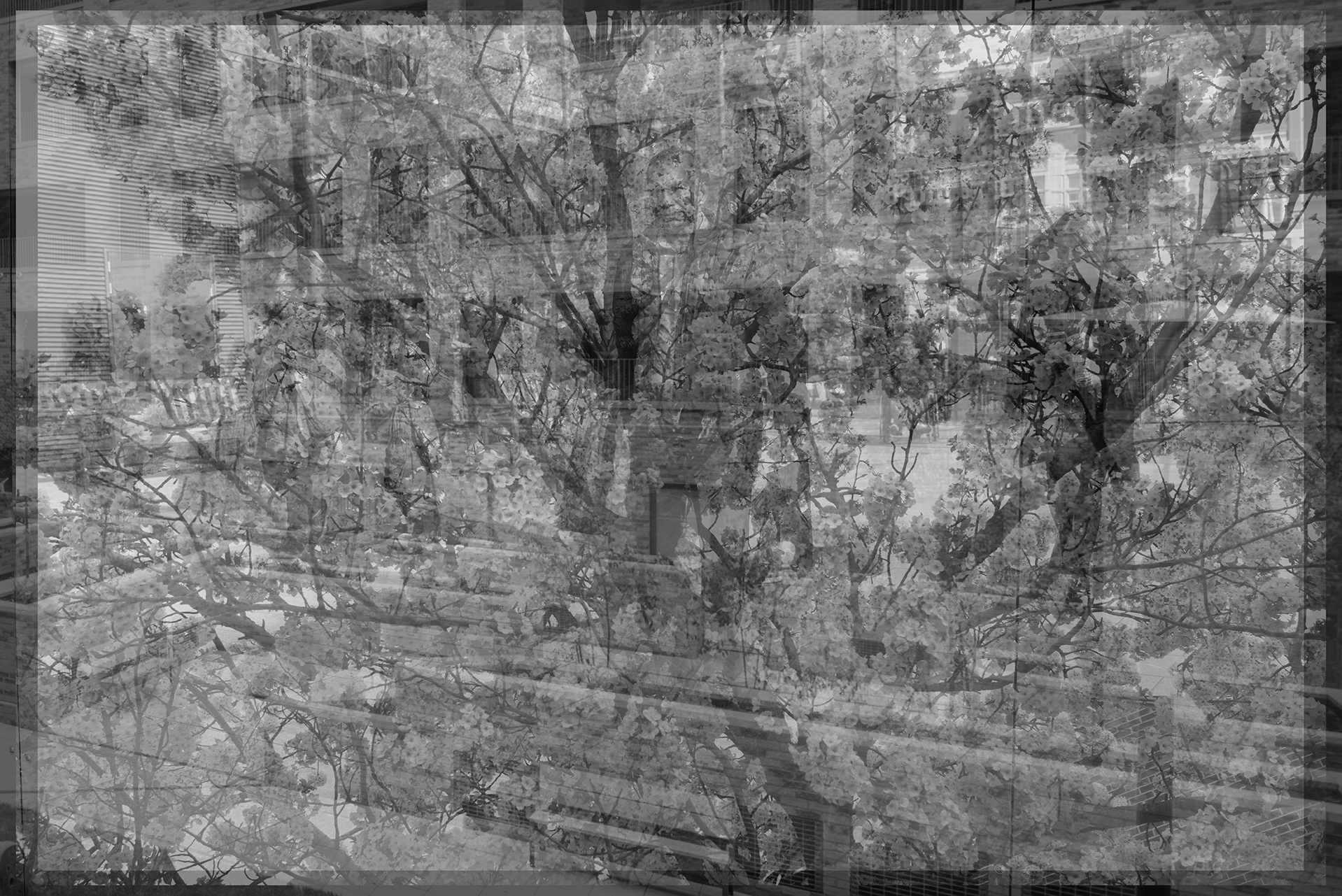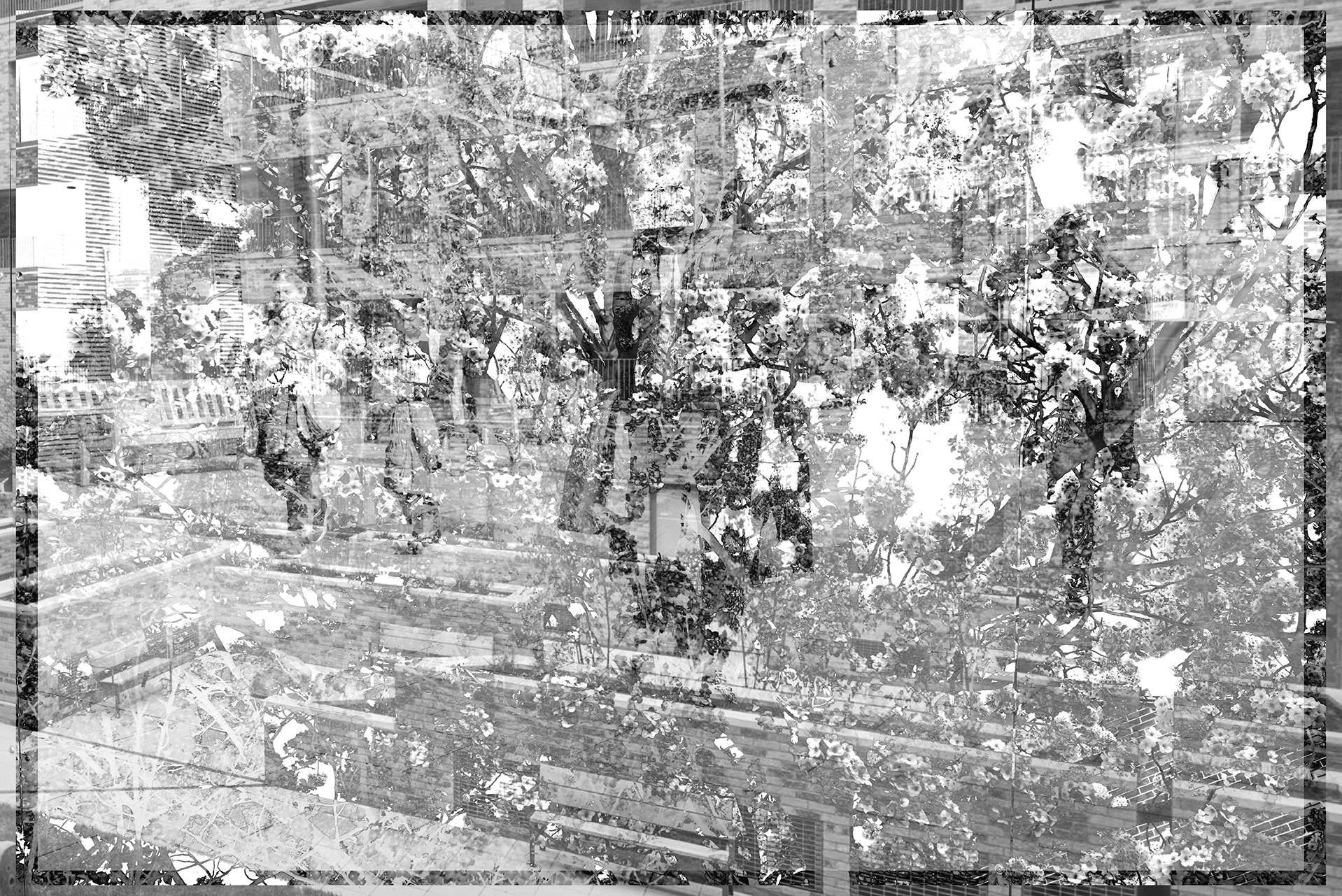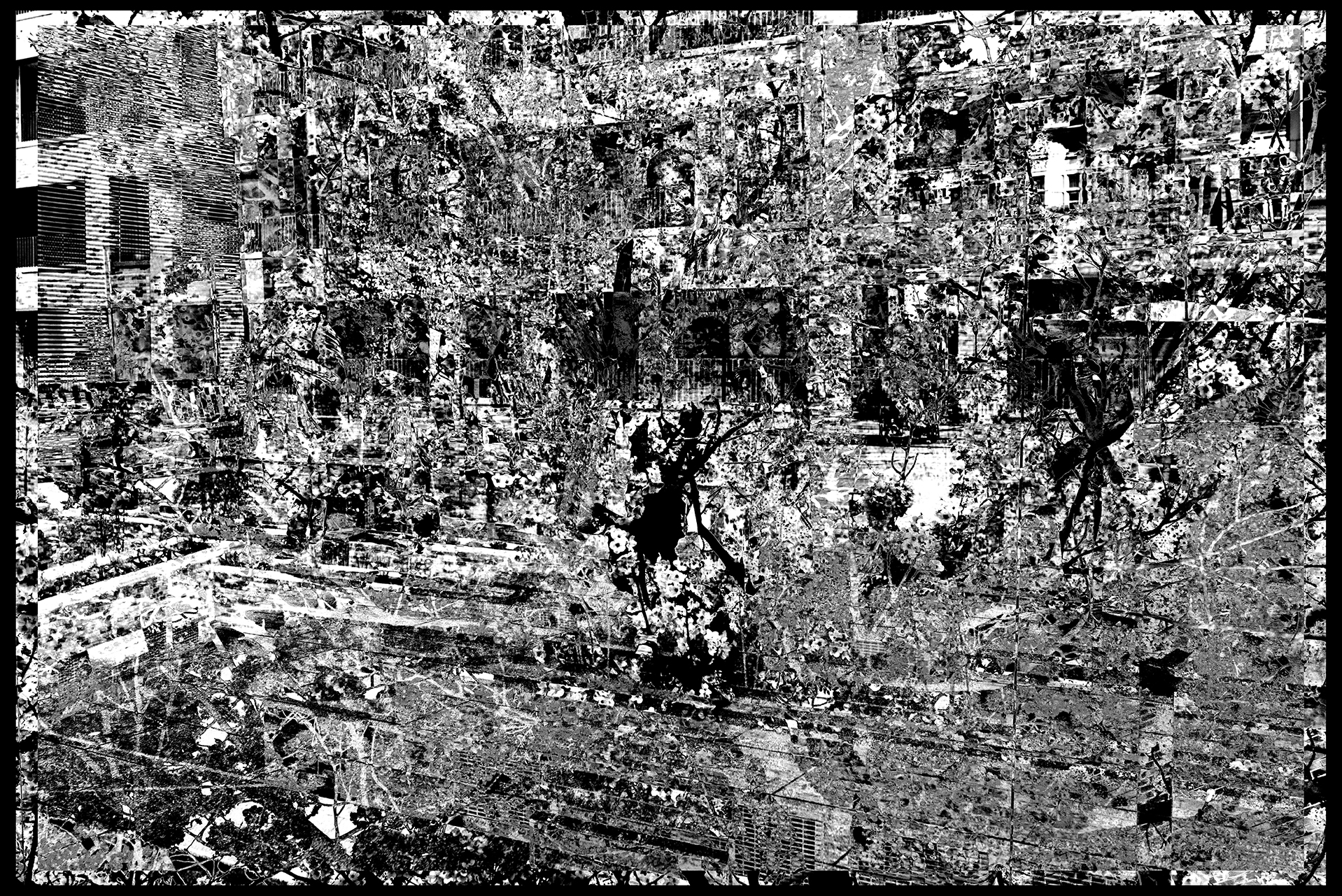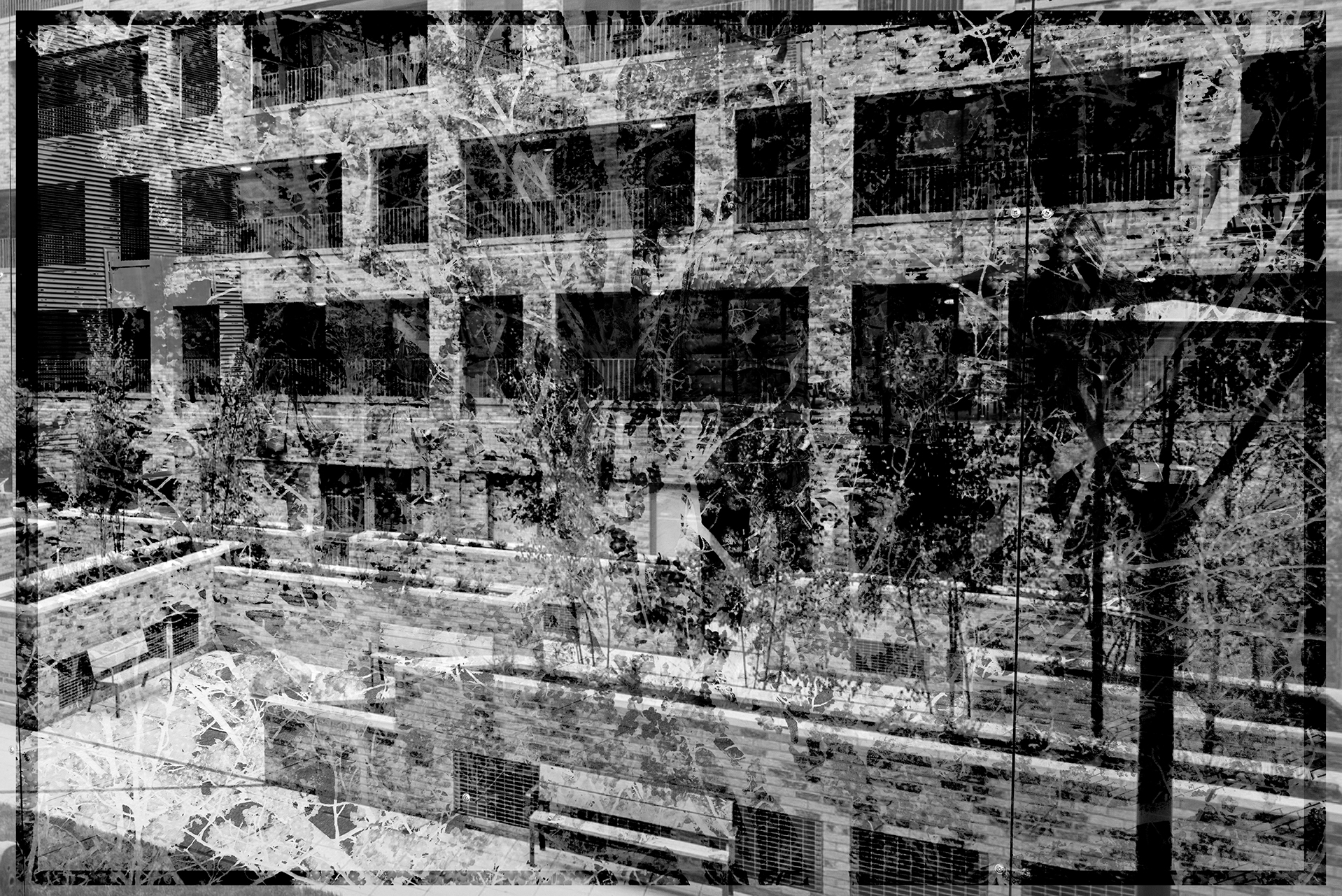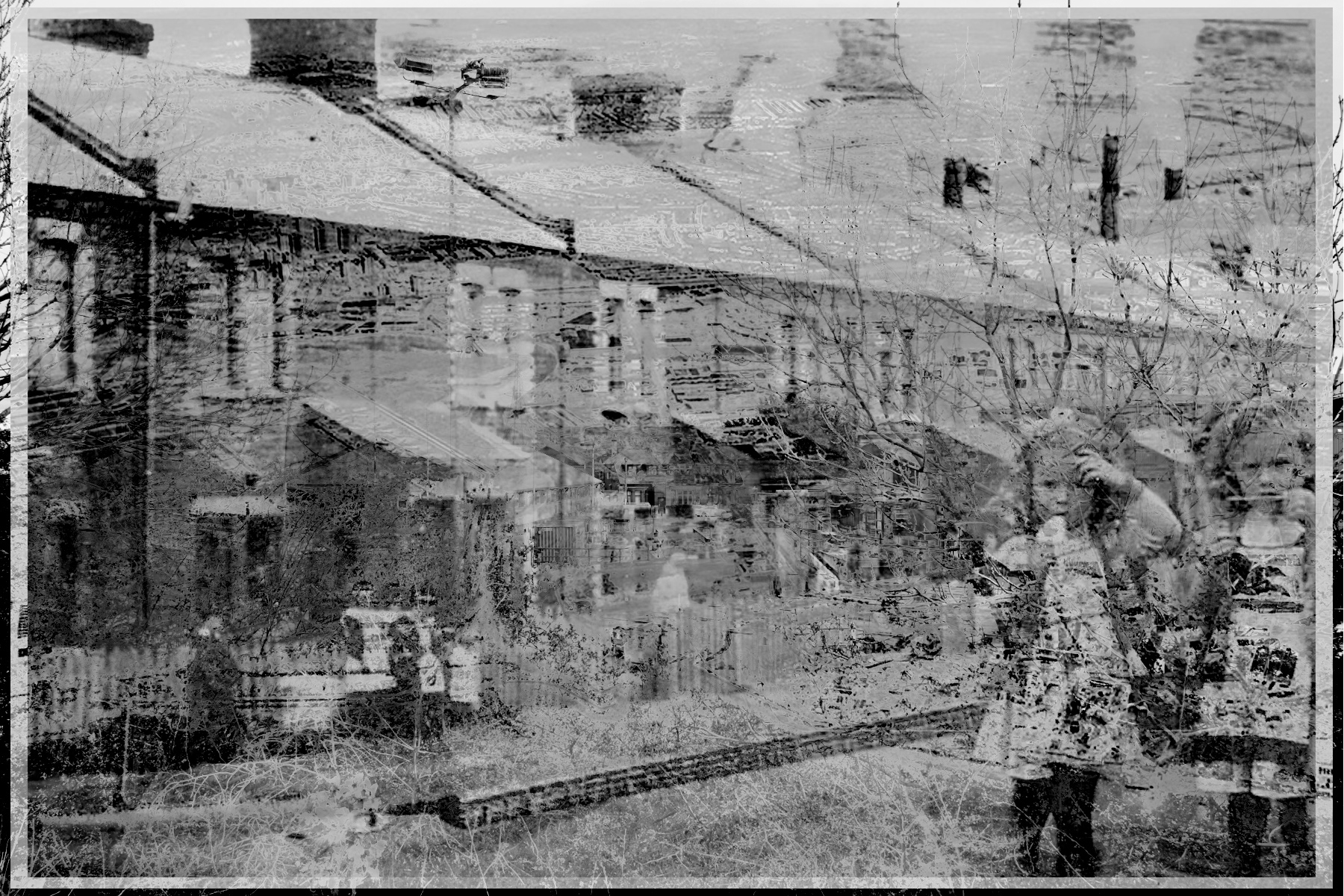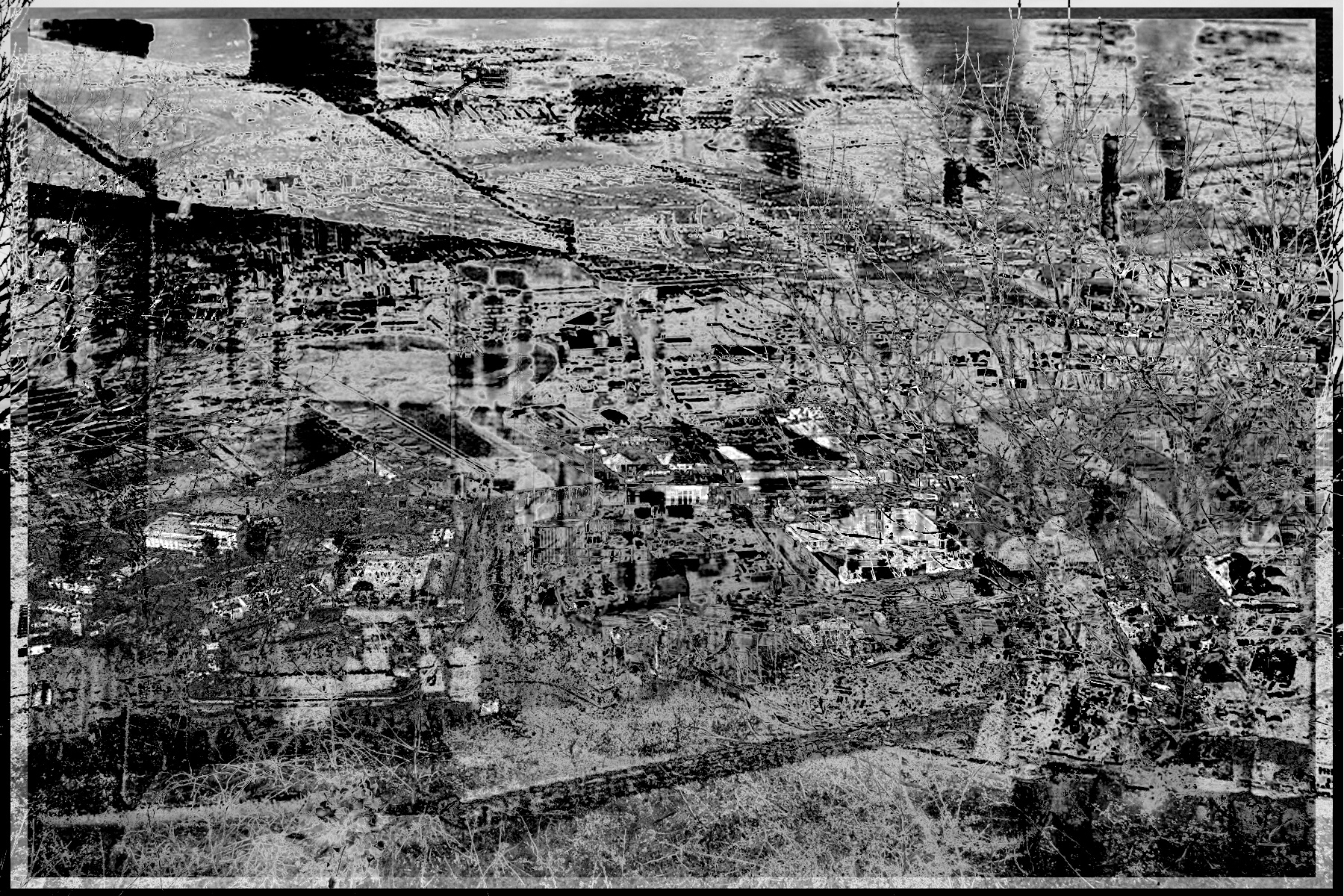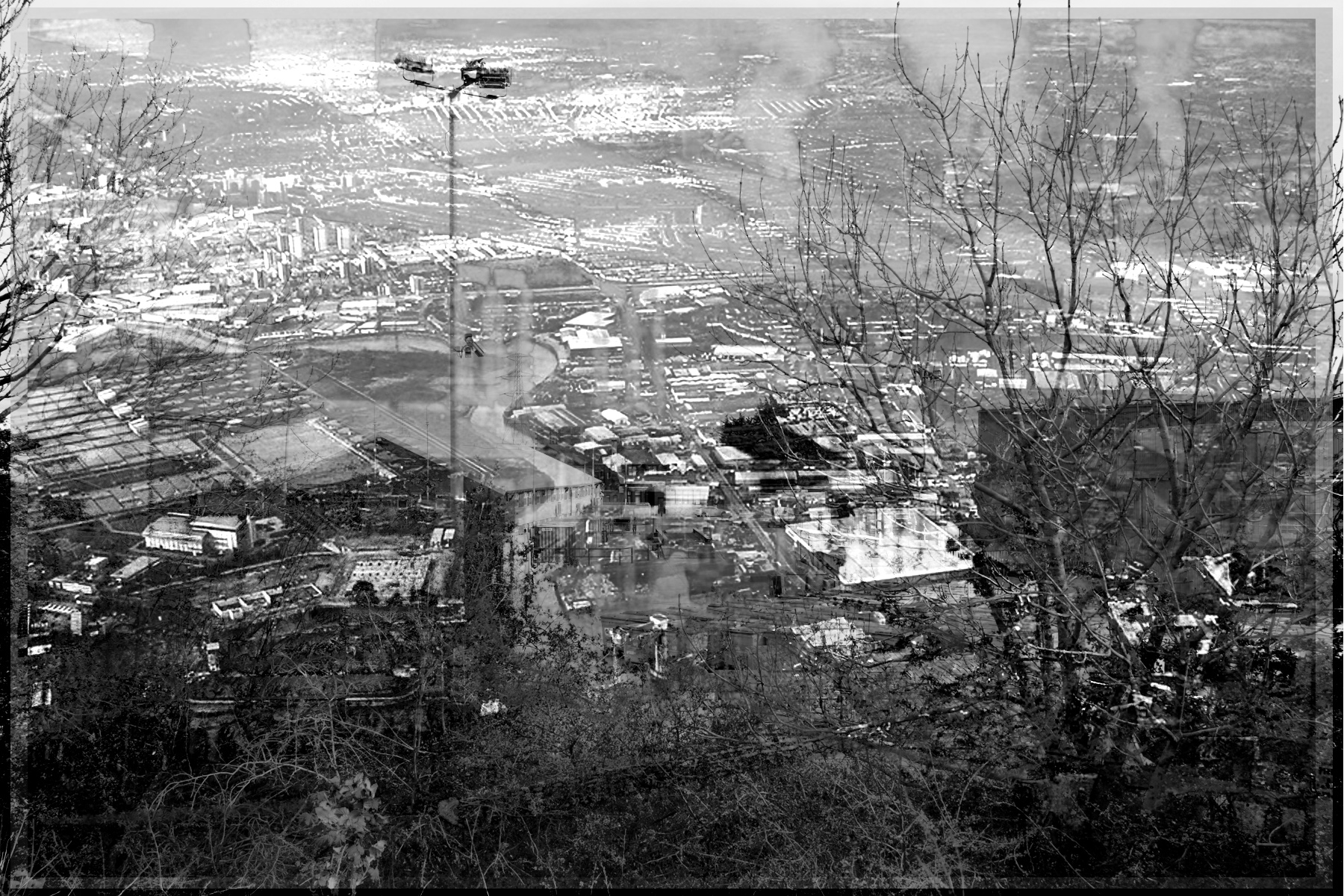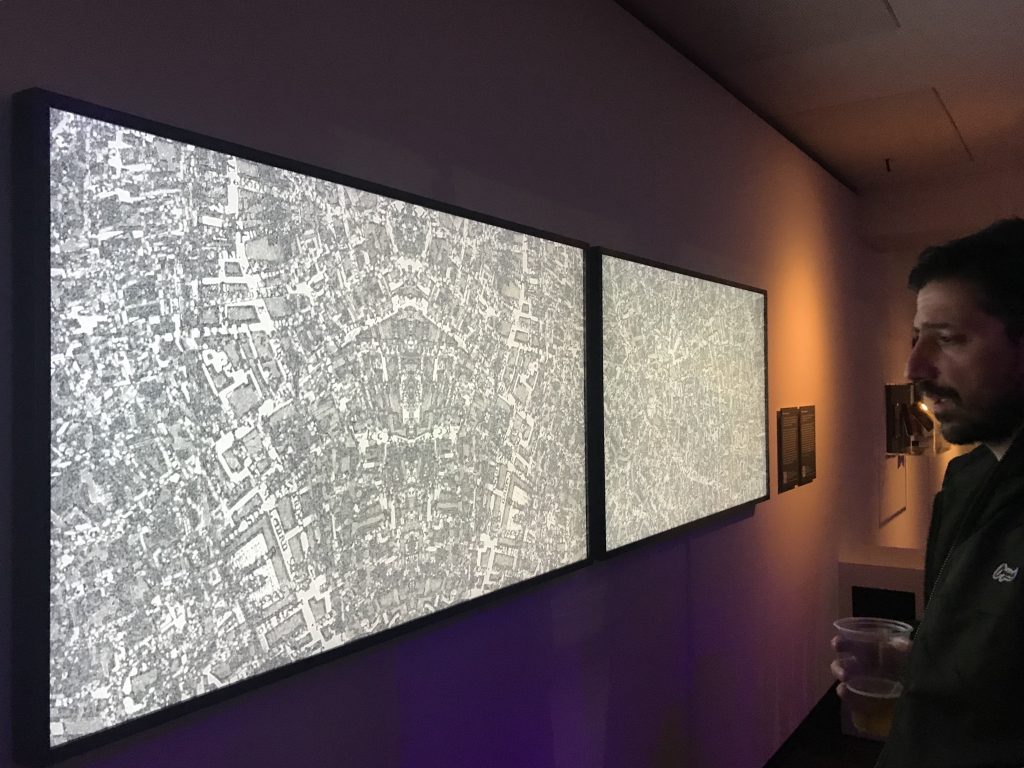Newcastle is a former steel town reinventing itself as a knowledge and creative industries hub. Whilst it remains the world’s busiest coal port, there is extensive development to reinvigorate the centre of the city, which hollowed out much in the same way as the centres of industrial US cities such as Detroit. Hunter Street, once the retail, administrative and commercial core of the city, is now at the centre of regeneration. I had read that in the decline of the UK high street, there had been a paradoxical flourishing of barber shops. So here are all the Barber shops in Hunter Street. Plus a vestige of a, not quite, bygone age, one of the ‘Gentleman’s Clubs’ and massage parlours that pepper the seedier end of the street. I followed the form of Nine Swimming Pools for this one, with colour images and a final tangential image, which provides a twist at the end of the book. The colour of the text for the title page is taken from the dominant brown colouring of the images (in the same way that the colour of the text in Ruscha’s book is taken from that of the pools).
Ruscha activity 1: Illegal Immigrants
My first shot. I made this while I was packing. It draws inspiration from Ruscha’s ‘Colored People’. The use by Ruscha of a contentious title (a demeaning, if not racist, term) draws attention to the problematic nature of a white artist casting a gaze on an(other) community, which is subverted by the, seemingly unrelated, content (which does, though, relate to the content of an earlier Ruscha book, but now with colour rather than monochrome images – this draws attention to the synchronic and diachronic dimensions in understanding a body of work). As a first attempt, my work is rather crude. As anyone who has traveled to Australia knows, there are strict interdictions on the import of plant and other organic material, and this is firmly policed at the airport. The government also sanctions harsh treatment of refugees and others seeking entry to the country, particularly those who travel by boat. I don’t want to develop this further, but its an interesting, if frivolous, attempt to get a feel for the format. I haven’t done the required photoshop work to get the full Ruscha look (which is important for this work, in that the tight masking of the images suggests a clinical/colonial gaze, which abstracts its object from context and lays it out for scrutiny, in the manner that, for instance, plants and animals are laid out for zoological and botanical analysis and classification, and different racial and social groups become objects in Galton’s racist eugenic project). Packing took priority, though.
Informing Contexts Critical Review
It’s been through a number of iterations, and edited down from around three times the length. I probably cut out the wrong bits. Plenty of material ended up on the cutting room floor that could provide the basis for worthwhile CRJ posts (rather than just get lost). I’ll work on that.
Andrew Brown IC Critical Review Final ReducedInforming Contexts Work in Progress Portfolio
This was submitted as an online portfolio. It is in three sections, each comprising of four images and an animation. How the images were produced is described in my Critical Review and elsewhere in the Critical Research Journal. The animations are here. The galleries below present the four images from each section. This is experimental work that I started about half way through the module. There is a long way to go in developing it further.
Relating practice to learning objectives (Week 11 Reflection)
My own objectives for this module were: (i) to explore new forms of image-making; (ii) extend my engagement with and knowledge of contemporary theory in photography and visual arts; (iii) develop a stronger conceptual basis for my practice; (iv) position my photographic practice within inter-disciplinary enquiry and multi-professional practice; (v) progress with my project, including the development of skills and networks. I think I have made good progress in all these areas. In this reflection I will relate progress with these to the learning objectives for the programme.
The reflection will be prospective (looking forward to the completion of the degree) as well as retrospective (looking back over Informing Contexts).
LO1: Technical and Visual Skills.
I came to the module technically and visually competent in particular forms of image making, working both in film and digital media. I wanted to both improve and extend the scope of my work, and experiment with new approach to image-making. The workshops and the portfolio reviews in Falmouth helped me with this. The principal areas of development over the course of the module have been in the shift to making constructed images (inspired by the early Informing Contexts lectures), the production of composites and the creation of animations – all new areas for me. See portfolio and CRJ entries. Alongside this I have continued to develop portraiture and still life work in community and museum contexts, and environmental and urban landscape work in the photographic study of urban regeneration. The work in my portfolio, though in the early stages of development, and the other images included in my CRJ, demonstrate that I have an in-depth understanding of a range of photographic processes, and I hope displays sophistication in the application of techniques.
LO2: Visual Communication and Decision-Making.
Focusing on the relationship between human activity, urban development and the natural environment, and exploration of conceptions of time in relation to this relationship, has helped me to develop a clear conceptual basis for the work and a clear visual strategy and method. This has informed decisions made in the production, editing and presentation of images (for instance, the inclusion of animations and the form taken by the online portfolio in as a mode of presentation of the work). There is still a lot to do to develop this work further. It is, though, just one part of the work I have been doing towards my project. I have also exhibited work in print form (for instance, the exhibition of portraits of community project participants at a local community centre, and the creation of image banks with community activist groups. I have also worked with museums and galleries and with undergraduate students on the use of photography in object based learning, and the creation and exploration of archives. Although my portfolio is presented online (which I feel is appropriate for an online course), my principal interest, in the presentation of work, is in the production of prints, books and artefacts and their presentation in multi-modal exhibition and installation form. I hope that the work in my portfolio demonstrates a level of sophistication in the production and presentation of my visual work and the ability to communicate complex ideas.
LO3: Critical Contextualization of Practice.
Ethical concerns about covert forms of photographic work led me into more collaborative forms of image making. I have continued to develop this with my community focused work and work with students and museums. Moving into more constructed and manipulated forms of image-making in this module has led me to explore a greater diversity of forms of work in photography and the visual arts. From my CRJ it will be clear that I have become particularly interested in the work of Japanese photographers (starting with Hatakeyama and Sugimoto, and more recently Lieko Shiga’s Rasen Kaigan series, which I will write about later) and other photographers who cross cultural boundaries (such as the aboriginal artist Christian Thompson: in my work in Australia, starting at the beginning of May, I will be working for part of the time with rural and aboriginal communities, and supporting research projects that have been making images and artefacts). The ‘digital’ turn in my work has brought me in contact with a range of artists exploring time, change, identity and ‘datafication’. I have become particularly interested in posthumanist theory, and artists who are influenced by this. I have explored this in my CRJ, as well as considering the influence on photography and the arts of areas of the humanities, social research and natural sciences (for instance, theories of space and time from theoretical physics). I’ll say more about theory under LO5 (LO3 and LO5 seem to me to overlap in relation to theory). As I am focusing on urban regeneration, there is a strong sociological influence on my work. I hope that through my visual work and writing, I have been able to demonstrate in-depth knowledge and understanding of a diverse range of contemporary (and historical) photographic practice, and to contextualise my work in relation to this and to contemporary theory. The area that I particularly want to develop now is around digitisation, data, social (in)justice and self, and, in particular, the manner in which contemporary desire for data to represent individuals and groups mirrors earlier (thwarted) indexical desires relating to photography.
LO4: Professional Location of Practice.
Over the module I have become clearer about how to position my practice professionally. Coming to better understand the professional contexts for dissemination and consumption of photographic practice has enabled me to clarify both what I do and do not do as a photographer. I am not a professional photographer in any conventional sense: my work is predominantly as part of inter-disciplinary and multi-professional teams, and I want to explore what photography, and arts based approaches more generally, can offer in conducting research into complex questions, and in formulating and implementing actions. My audiences are, therefore, diverse, ranging from the participants in my projects through to academic researchers and policy makers. I am working at all levels from image making with community members through to playing a role in the governance of public bodies. I have come to understand better the dynamics of the fields in which photographers work, and want to actively act as an advocate for a broader vision of what photography can achieve more widely. At this point of time it is necessary, in the face of new imaging technology, software, data analysis, communications, associated social practices and applications of artificial technology to rethink all professions: photographers have to be pro-active in doing this, and to be clear, and confident, about what visual arts can bring to inter-disciplinary work. I’ve explored this elsewhere in the CRJ.
LO5: Critical Analysis.
Having taught social semiotics and cultural sociology, I came to the module with some knowledge of the key critical paradigms and theorists (in particular structuralist and post-structuralists like Barthes, Foucault, Derrida and Lacan, Frankfurt School critical theorists such as Benjamin and Marcuse, and sociologists, such as Bourdieu and Sherry Turkle). My own work has been broadly post-structuralist in approach, with a strong emphasis on language and the analysis of discourse in relation to social practices and the (re)production of social inequalities. My focus in this module has been to better understand posthumanist theory, which takes a more materialist stance and not only de-centres the human subject, but sees humans as materially intertwined and enmeshed in the environment. This gives greater emphasis to neuro- and bio-sciences and to relationships with the environment, objects and other species. Forms of posthumanist theory have been influential in the arts, and where I have explored this in my CRJ, it has been in relation to the work of other photographers. I have also explored areas of contemporary philosophy, for instance Harman’s Object Oriented Ontology and Francois Laruelle’s non-philosophy. Critical appraisal of my own photography and that of other practitioners draws on this work, as well as on perspectives from social research, urban development, environmentalism and cognitive neuroscience, and engagement with the work of other photographers and visual artists. As would be expected from this, I am using photography in a lyrical, analytic and heuristic manner, not as a narrative tool, and therefore have limited expressing opinion on narrative forms of photography (but have written about this in a way that is, I hope, constructively critical about ‘story-telling’). The module has expanded my knowledge of critical theory in photography.
LO6: Written and Oral Communication Skills.
I am confident in my ability to communicate fluently and eloquently in a range of formats and contexts, and to differentiate delivery methods appropriately according to audiences, and hope that my written and visual work, and participation in webinars and face to face activities, demonstrates this. In addition, I am working with community groups and individuals on estates in east London, running photography workshops for undergraduate and postgraduate students and working at board level in the areas of education, urban development and social research, so have to communicate and engage people with my work at a range of levels and in a variety of forms. I’m increasingly confident in using visual modes of communication, and the use of social media. I am based in London, but work internationally, so am able to work collaboratively online, and doing the MA has certainly helped to develop my online communication skills.
In Defence of the Grey Image
[With apologies to Hito Steyerl].
Interesting presentation from Sam Laughlin on 10th April. Although the focus of Sam’s work is predominantly rural, he is exploring a number of issues that overlap with my own work, which is predominantly urban. In relation to Informing Contexts, he provided a particularly strong rationale for his work, and related his objectives very clearly to his way of working, the forms of images produced and how these are displayed.
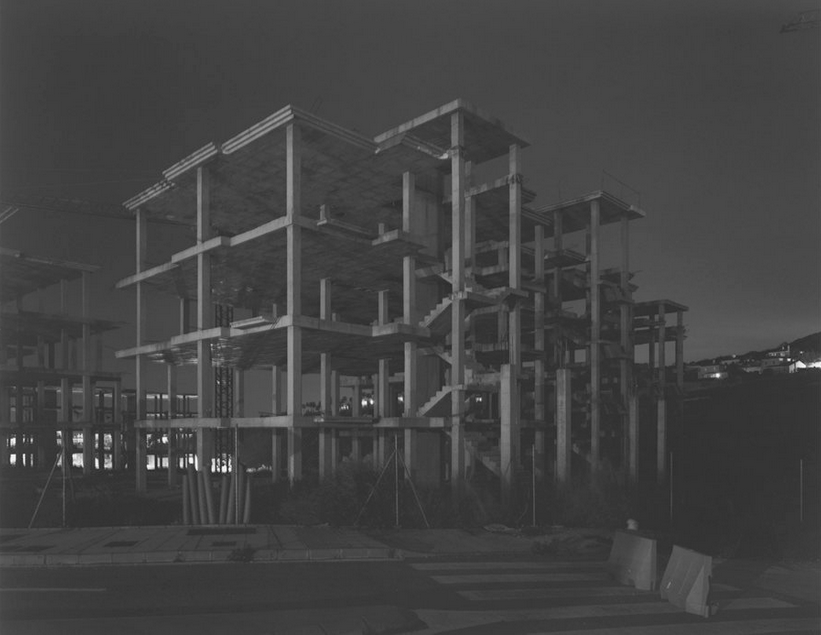
Frameworks explores the essence of a building, before it becomes architectural space. A clear set of criteria guide the selection of sites (with extensive location scouting), and a firm set of operating principles guide the production of the image (working at night, large format camera, small aperture, long exposure) and the ultimate aesthetic form (a ruin in reverse, transparency, the sense of an Escher print, the suggestion of an object). The ‘greyness’ of the image forces the viewer to explore every part of the frame, with no colour, high contrast or strong lines to guide the eye. In many ways, this reflects a concern about my own recent images, which I now see as a strength. There is a need to search, but this turns up unexpected interactions and artefacts.

The same aesthetic is evident in Laughlin’s subsequent work, which focuses on natural cycles (nutrients, water). These images have even less structure, and the subject in some cases is difficult to discern. This places an emphasis on the process even more on the suggestion of subject. Laughlin has thought carefully about how this work is exhibited, displaying print directly on the wall without glass (so as to engage the viewer directly with the work without the distraction of reflections or frame) and using print size, scale and placement, and juxtaposition with objects and artefacts to guide and provoke (but not direct) engagement. The work is clearly not made for online viewing, and this raises questions about how best to promote the work and cultivate an audience.

I wasn’t expecting to be working in black and white (though the rationale for this is now clear) nor to be producing such complex images (likewise). It is clearly the least graphic (and therefore the ‘greyest’) images that work best. There are similarities with images produced by Idris Khan and Sohei Nashino in tonality and complexity, and absence of visual guidance for the view (but both do provide points of reference given the emphasis on a specific place, albeit at different scales, and different form of composite image making). A clear issue for me, in developing this work, is how best to circulate and display the images.
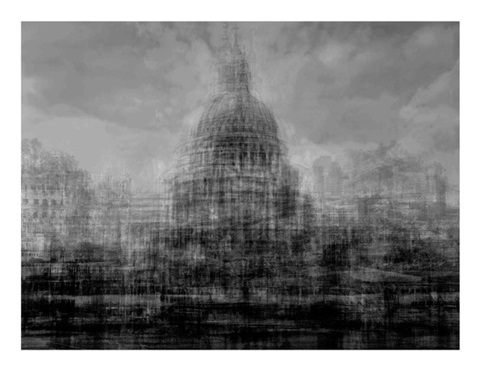

Imaginary Cities
British Library, 5th April 2019
The exhibition presents four technology-based installations that derive from images of 19th-century maps, and associated meta-data, held in the British Library digital collection, created by digital artist Michael Takeo Magruder (an artist in residence at the British Library) with collaborators Mahendra Mahey (British Library), Drew Baker (independent researcher) and David Steele (software architect).
Of particular interest in the development of my own work is the movement between analogue and digital. The maps themselves are exemplary analogue representations, which have been digitally archived. The archiving process produces not just a digital (re)presentation of the map, but adds meta-data to this (effectively a digital encoding of the narratives, for instance of origins, authorship, circulation, association, ownership and functions that become attached to and associated with the map as artefact). The meta-data itself becomes subject to processing, and thus available in the production of artwork relating to the maps. With the map as a point of origin, a data trail is formed, and from this artworks are created.
A conversation with artist Michael Takeo Magruder
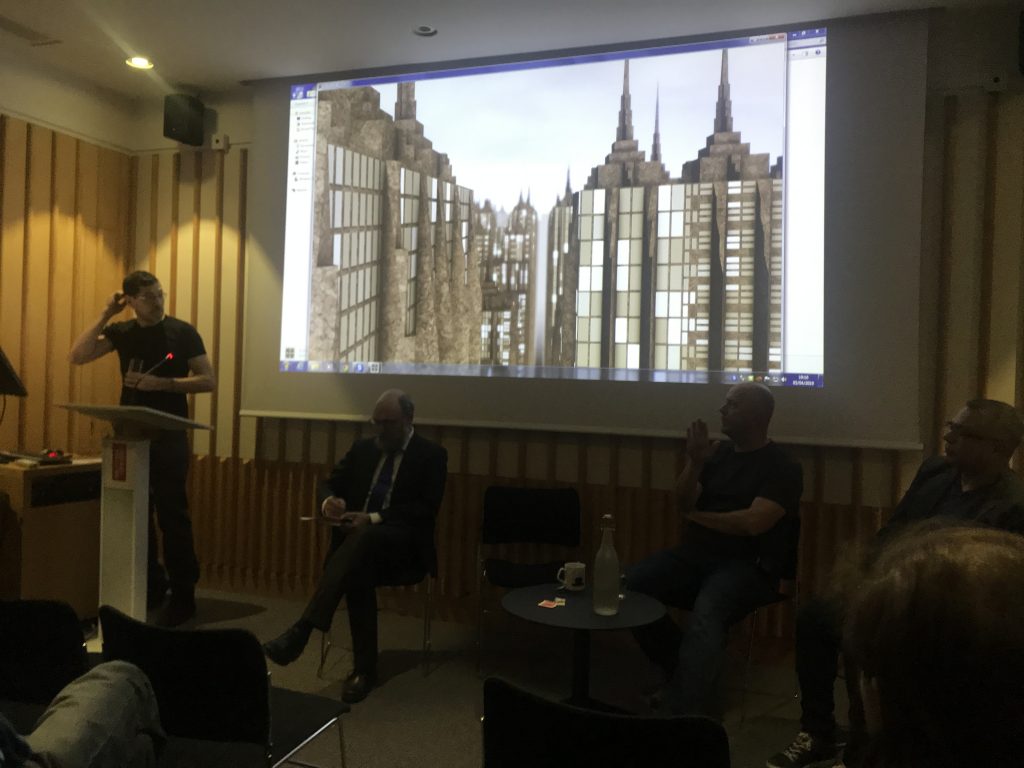
The talk provided insight into the process of production of the work. Magruder is interested in production of tangible objects, including the use of traditional craft techniques. Outputs from this project include 3D and digital prints, and objects made with wood and gold – analogue and digital together. He also uses prosumer and consumer VR in to allow visitors to explore the imaginary city produced from maps of New York. He sees himself as applying the language of the visual arts to things that are ‘digitally born’. Previous work has been about visualising data; this is about visualising (digital) archives. Drew Baker explained the process of production of 3D visual content from real-time data (as an archaeologist he relates this back to the process of finding, extrapolating, understanding, archiving, disseminating and exploring archaeological material – lost and marginal spaces). David Steele, software architect, explored the process of building a continuous archive (with minimal intervention and maintenance) and processing of information. Interestingly, he presented the relationship between software engineers and artists in the production process as similar to Sol Lewitt’s use of instructions to galleries in creating exhibitions (this might also bring to mind Jeff Koons’ production of sculptural work – providing an instruction set, oversight, quality control, authentication).
It is clear that there is huge potential to draw on the BL digital collection and to do collaborative work. There are interesting questions to explore about the relationship between place (as represented in the maps) and the artworks (imaginary cities) produced, and the nature of the ‘processing’ (both analogue and digital) that sits between these. I was tempted to say that this is uni-directional (the process of creation of the work, but, of course, the viewer remakes a pathway back from the artwork (to another imaginary place). There are obvious analogies with my own current work, which creates imaginary scenarios from the manipulation of digital interaction between images. The starting conditions are ‘real’, in the sense that they are photographs of human activity and the environment in a particular place at a specific point in time (and we can therefore exercise our desire for the indexical promise of the photograph), from which a number of fictions are created by bringing the images together and varying the conditions of their interaction. Those conditions relate to the visual (in that they depend on the translation of colour into tones, and the combination of those tones). The question is, though, whether that is any more or less arbitrary than any other principle of translation. In the installations, numerical data (some derived from visual sources, some not) are translated into visual form. The principles (or, in other words, the algorithm, programme or software) by which this translation takes place can exhibit differing degrees of arbitrariness – an imaginary city can be generated from any starting point and develop according to any principle. However, the artist (if it is an artwork) has to account for this in their rationale (or intent).
One interesting observation about the process of creating an interactive environment was the use, by the programmer, of a cryptographic hash to obscure the relationship between the viewer and the effect on the work, to stop viewers from ‘gaming’ the system, and learning how to control it by getting a ‘feel’ for the algorithm.
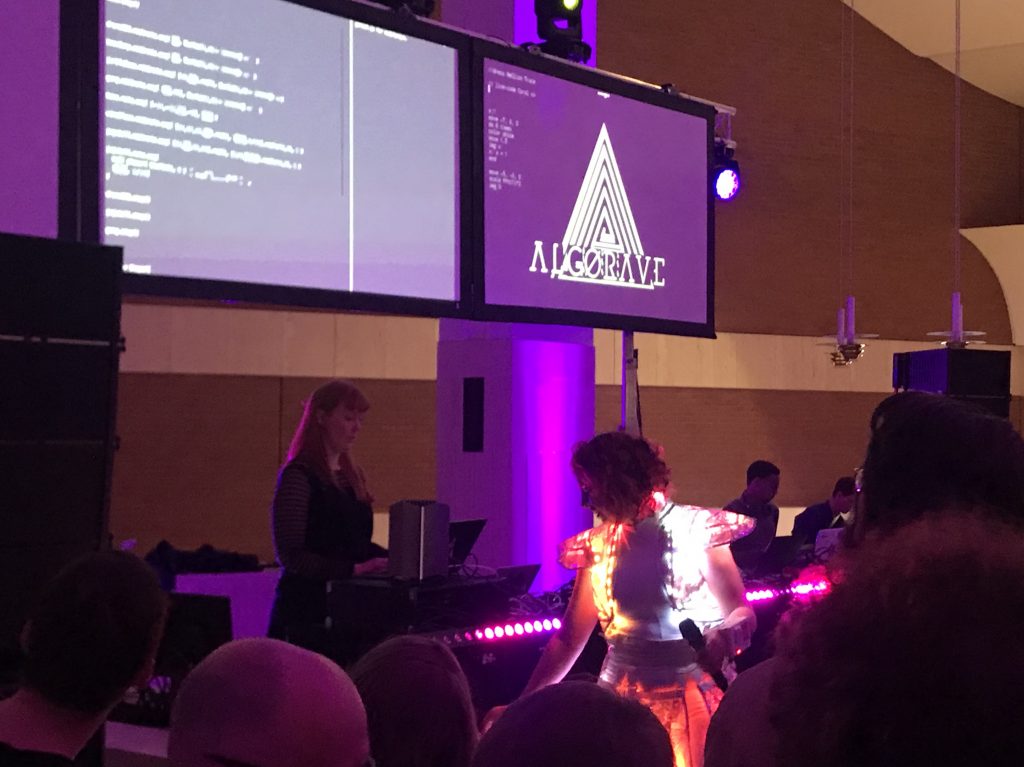
The algorave (billed as ‘the world’s largest algorave in a national library ever’!) was also interesting in this respect. Here we have code generating sound (and visuals, through light shows and projections), some through intention, some through response to the environment, some through arbitrary or random processes (including glitches in the hardware, software, data, programmer). Heuristically, there are also questions about what we learn about the initial and final state, the process, about ourselves and others (as creators, as audience, as collaborators).
References
British Library Digital Scholarship Blog. Online https://blogs.bl.uk/digital-scholarship/ [accessed 24.04.19]
British Library Digital Scholarship Department. Onlinehttps://www.bl.uk/subjects/digital-scholarship[accessed 24.04.19]
Michael Tadeo Magruder. Online http://www.takeo.org/[accessed 24.04.19]
Contexts of Consumption (Week 9 Reflection)
The focus this week has been on the places where people come in contact with photographic art, and ‘contexts of consumption’. I want to use this to take the opportunity to reflect on the form that my own photographic work is taking and how this can be circulated, displayed and made public. Each of the three aspects of my project with produce different kinds of outcomes, and will have different primary audiences. I’ll consider each of these in turn. It is important, however, to think about the relationship between these different forms of work and the manner in which the different audiences, and the contexts in which the work is encountered, relate to each other.
My project explores community engagement with urban regeneration in east London. The overall objective is to use photographic image making to explore how regeneration is impacting on communities and how groups and individuals can influence these developments to ensure that they benefit the people who live in regeneration areas. To achieve this, I am
(i) working with residents to explore their experiences and understanding of and aspirations for development of the areas in which they live through their own image making;
(ii) working collaboratively with community groups to produce photographic images to be used in campaigning and advocacy;
(iii) developing my own photographic work to explore the relationship between community and environment in the light of regeneration and gentrification of areas of east London. These are discrete, but inter-twined, bodies of work which act to inform each other.
The photographs produced in (i) are part of the process rather than being outcomes. They act as artifacts which provoke discussion and help gain insight into the lifeworlds of the participants. The outcomes of the work can be in a number of forms, including text with images. The audience for the work are the community members themselves and other individuals and groups who work with the communities, including planners, developers and local authorities, and activists and academics. Books and other print and online publications are likely to be a primary means of dissemination of the outcomes of this work. The images produced in (ii) are most likely to act as resources to be used by community groups to meet their own objectives. They could constitute a repository of images to be drawn on. This is what I have done with the Thames Ward Community Project, and they are using images I have produced in presentations, posters and publications about their work. It can also lead to exhibitions, for instance the recent exhibitions of portraits of participants in a community project at a local community centre.
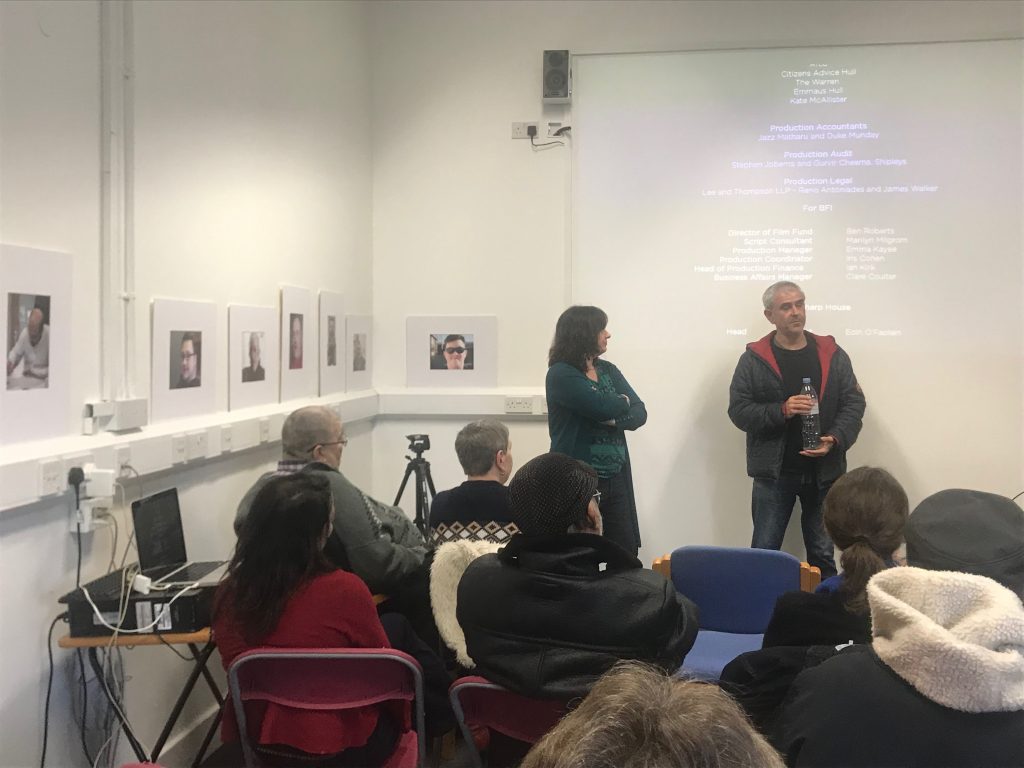
Other photographers who have carried out this kind of work include Emma Blau (who exhibited her portraits of members of the community on a west London housing estate on holdings around the estate).
Julian Germain similarly exhibited images made by and with the community in a favela in Brazil in community spaces, and also produced a newspaper containing these images, a strategy used by Simon Roberts in his work on the UK general election. Dana Lixenberg set up an online repository for her own images and those made by the community in a Los Angeles housing project. Wendy Ewald engaged members of the community in Margate in making images and displayed these with accompanying text in novel public spaces (for instance, on the side of Dreamland, as in the photograph below).

The key here is find ways to actively engage members of the local community in ways that is also able to attract the attention of a wider audience (as, for instance, Jermain and Roberts have done through books based on their projects).
It is the third area of work, my own photographic response to the contexts I am exploring, that is most likely to lead to wider dissemination and engagement beyond the immediate community. The exhibitions of the Urban Photographers Association would be one possible outlet for the kind of work I am doing, for instance The Urban Condition: Photography and Urban Cultures, a group exhibition in 2017 which explored urban place and space from a number of different perspective.
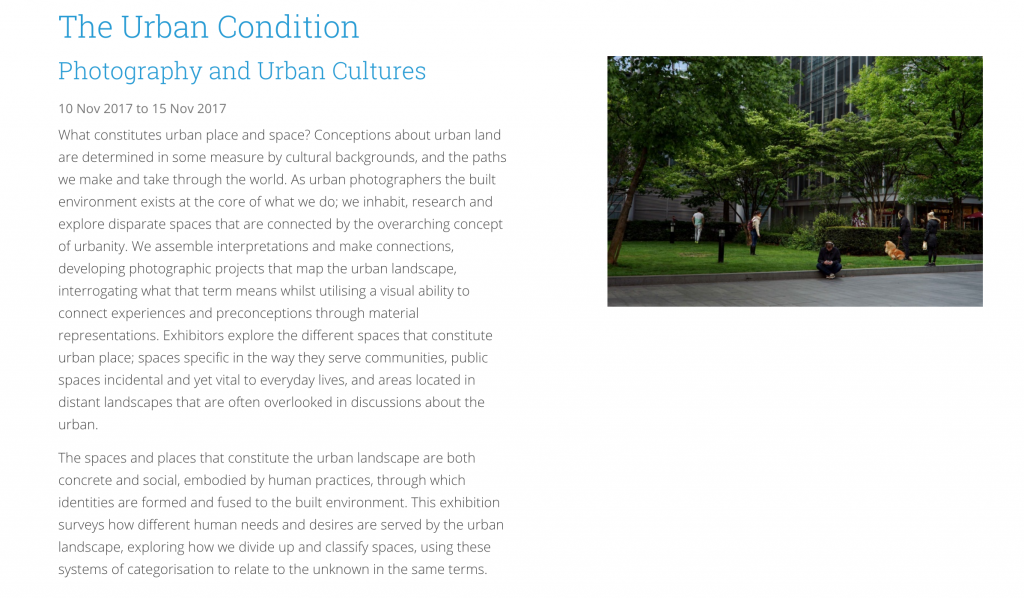
My current work, which addresses the relationship between space and time in the context of urban development and the natural and built environment, would appear to fit with the brief of exhibition and the intent of the artists whose work is represented. If this work achieves a greater degree of development, exhibitions around a particular theme, such as the Living with Cities exhibition (2018) at the Wellcome Foundation (see my post on this exhibition here), would also be a possible vehicle for dissemination.
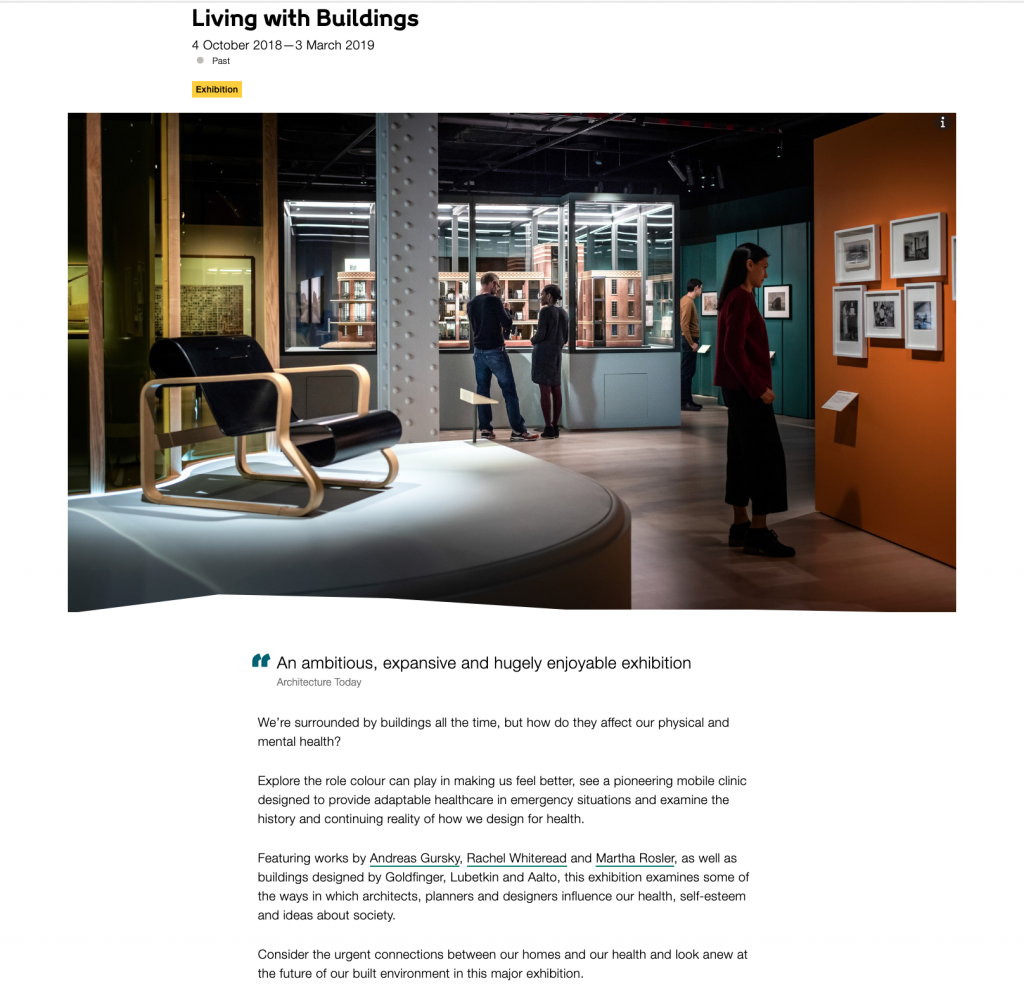
Over the past two weeks, I have also been to a number exhibitions in which a range of forms of work has been presented around a theme, creating mixed media exhibitions in gallery settings. For instance, the Deutsche Borse shortlist includes mixed media work addressing issue of abortion, terrorism, migration and the environment (see my discussion of this work here, and for the Colour and Poetry exhibition here and Moving Objects here). Whilst the gallery is clearly a privileged space to which there is unequal access in relation to social class (Barker, 1999; Bourdieu & Darbel, 1991), strong links can be made with other modes and sites of engagement, creating new possibilities for dialogue, one of the key motivations for the three forms of photographic practice represented in my project.
References
Barker, E. 1999. ‘Introduction’. In Barker, E. (ed.) Contemporary cultures of display. New Haven: Yale University Press in association with the Open University: 8–21.
Bourdieu, P. & Darbel, A. 1991. The Love of Art: European Art: Museums and their Public. Cambridge: Polity Press.
Artist’s websites
Emma Blau. 2016. Face Forward. http://www.faceforward.photo/ [accessed 01.04.19]
Dana Lixenberg, 1993-2015. Imperial Courts. http://www.imperialcourtsproject.com [accessed 01.04.19]
Wendy Ewald, 2003-6. Towards a Promised Land, Margate. http://wendyewald.com/portfolio/margate-towards-a-promised-land [accessed 01.04.19]
Julian Germain. 1995-2007. No Olho da Rua. http://www.juliangermain.com/projects/no-olho.php [accessed 01.04.19]
Simon Roberts. 2010. The Election Project. https://www.simoncroberts.com/shop/election-project-newspaper [accessed 01.04.19]
Moving Objects Symposium and Exhibition.
UCL Institute of Advanced Studies Common Ground, 14th March 2019.
The ‘Moving Objects’ symposium was held to launch the ‘Moving Objects: Stories of Displacement’ exhibition at the UCL Octagon space. The exhibition explores people, animals and objects in exile, in the UK and the Middle East. It includes photographic work by migrants in London created through a series of workshops held by the Helen Bamber Foundation. This work explores the ambiguity of objects as they move through everyday and museum settings. The work examines both exiled and migrated objects and the capacity of objects to move us.

The symposium explored issues raised by a number of inter-disciplinary projects carrying out research on objects, migration, heritage and well-being. The ‘History, archives and displacement’ panel explored the role of writing and the arts, including photography, in creating critical spaces and different ways of seeing, feeling, hearing, understanding and being with individuals and communities affected by displacement (see, for instance, the Refugee Hosts project). Heritage objects (the real and the wished for) play a key role in the empowerment of communities. Archives need to be dynamic, allowing reflexive questioning and capable of projecting into the future, including wishful futures. The archive must ‘have wings’ not be a cemetery, or sink into the past; objects should facilitate comment and desire their own redundancy (Leila Samsur talking about Open Bethlehem ). See, for instance, the Unpacked: Refugee Baggage series by Mohammed Hafez.
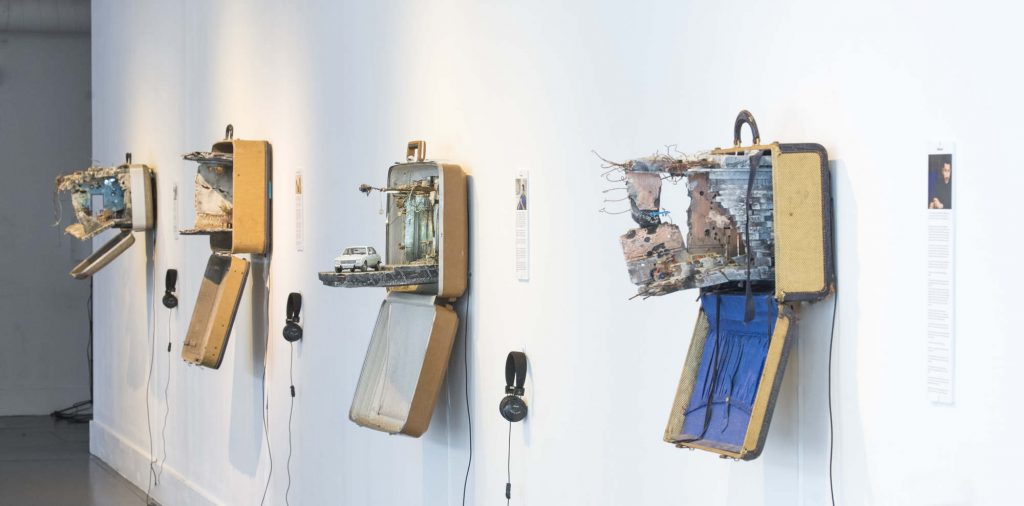
And, as Derrida (1995) observes, we have to closely scrutinise what enters the archive and what does not. For my own work, care has to be taken not to create something that is reductionist and backward looking. The idea of a portable archive is one avenue to explore.
The Photography and Displacement panel included a presentation by Alejandra Carles-Tolra on the Helen Bamber Photography Group workshop, which includes handling and discussion of objects from the UCL collections (the objects providing a focus for discussion, fun and conversation). The images made by the group members are shared and discussed through WhatsApp and shared Google folders.
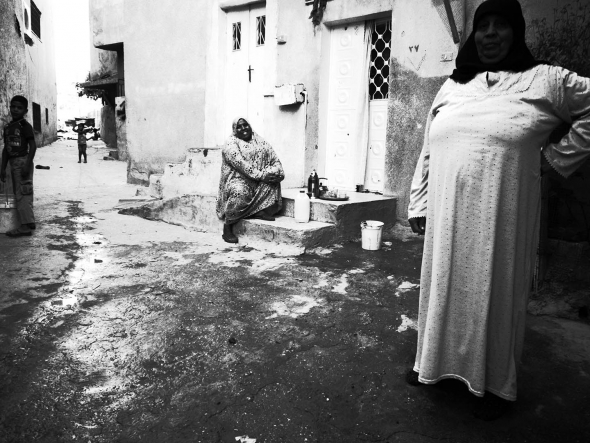
Samar Maqusi presented her research on the spatial politics of the Palestine refugee camps, and the role played by installations and photographic work in the research. Spending time in the place was important (it is a pre-cursor of image making and can be ‘seen’ in the frame; she raises the question of whether powerful personal stories can be told without being in the frame), and the camera was viewed as a mechanical bodily enhancement. Time (excess including waiting time: what does waiting do to hope?) and space (limitations) are intertwined in the camps. The presentations reinforced the importance of spending time with people to understand their context, their relationship to time and their relationship to space and place.
References
Derrida, J. 1995. ‘Archive Fever: A Freudian Impression’. Diacritics, 25 (2): 9-63
Multiple Messages (Week 8 Reflection)
My work on community engagement with urban regeneration involves working closely with communities and learning about the proposed developments and their impact on these communities and the environment. Making images is a part of this process. These images are part of both relationship making and the process of identification of themes and approaches. There are messages in this work, but as photography is being used heuristically (as part of the process of investigation, not necessarily in the production of final outcomes) these messages are formative and transitory. Over the course of this module, I am developing my own artistic response the the contexts I am exploring.
Photographic work in these contexts (urban regeneration and gentrification) has largely focused on the experiences of members of the communities affected by the changes (for instance, in different ways, Zed Nelson’s and Tom Hunter’s Hackney portraits and Emma Blau’s work with residents of an estate in West London, or Dana Lixenberg’s work with residents of the Imperial Courts social housing project in Los Angeles), or on the impact on the built environment of urban development (for instance, Metropole by Lewis Bush looking at developments around central London and Chris Dorley-Brown‘s studies of areas of East London over time).

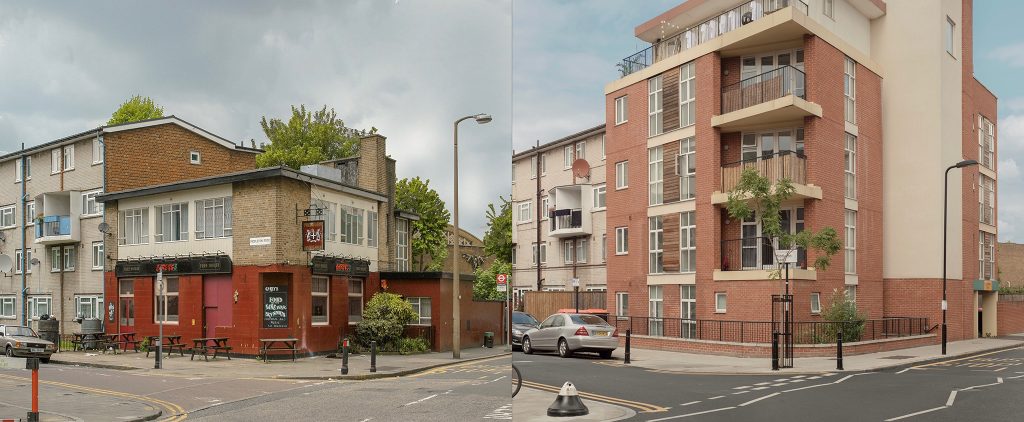
My work is taking a different direction. A dominant concern is the disempowerment of communities in the urban development process. Producing images with and for communities, to be used in advocacy and campaigning, addresses this in part in terms of action (with much to learn, in terms of both theory and practice, from Martha Rosler’s ‘If you lived here …’ project, see comprehensive account and analysis in Wallis, 1991). It leaves open, though, how my own image making will address this issue. Invoking the passage of time, the interaction of the human and natural in the environment and the social and environmental impact of current and future urban development. The use of digital manipulation, and animation, in my recent work has led me to look at how others have addressed these issues digitally, whilst still aspiring to produce artifacts alongside images (and images as artifacts). Amongst the artists discussed in Wolf’s (2010) survey of photography in a digital age, the passage of time is addressed through composites by Jason Salavon and mapping and algorithmically generated images by Siebren Versteeg.
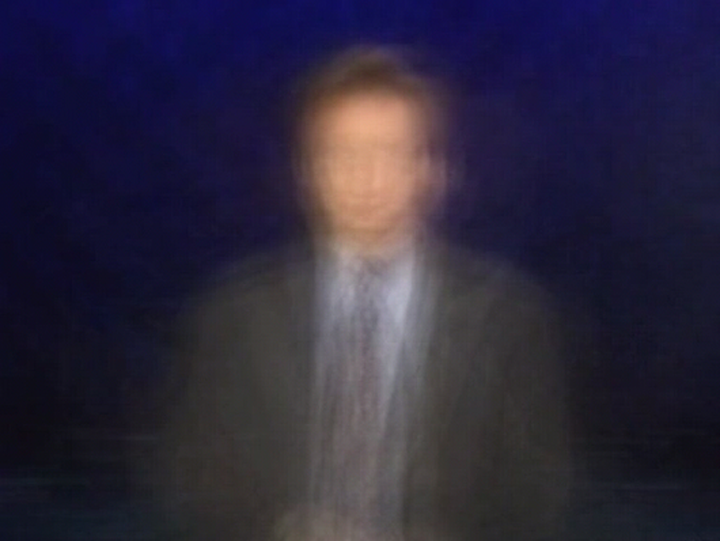
To loop back to the initial question for this week’s reflection, I do aspire for there to be multiple messages in my work, whilst recognising, indeed celebrating, the lack of control that the artist has in the reading of their work, and the possibility that it will produce new meanings for those who engage with the work (see Barthes, 1967, and Foucault, 1977, for critical consideration of the notion of authorship). Intent enhances the coherence and direction of the work, but does not determine its meaning or constrain its potential messages. The process that I am developing acknowledges, and, I hope, is able to be animated by, that indeterminacy. Prevailing social, cultural and economic conditions will always entail that there are perceived better and worse (in the moment, readable and incomprehensible) carriers for these messages, which makes it important to position the work, and index its intent, in relation to other work in the field (see Bourdieu, 1990, for discussion of the notion of field with respect to photographic practice).
References
Barthes, R. 1967. ‘The Death of the Author.’ Aspen: The Magazine in a Box. 5+6. UbuWeb: http://www.ubu.com/aspen/aspen5and6/index.html [accessed 25.03.19]
Bourdieu, P. 1990. Photography: A Middle-brow Art. Cambridge: Polity Press.
Foucault, M. 1977. ‘What Is an Author?’ In D. F. Bouchard (ed.) Language, Counter-Memory, Practice: Selected Essays and Interviews. Ithaca, NY: Cornell University Press. 113-38.
Wallis, B. (ed.).1991. If you lived here : the city in art, theory, and social activism. Seattle: Bay Press.
Wolf, S. 2010. The Digital Eye: Photographic Art in the Digital Age. Munich: Prestel Verlag.



